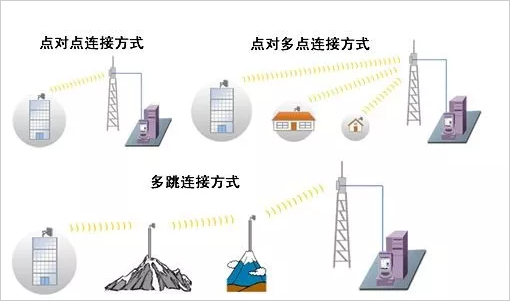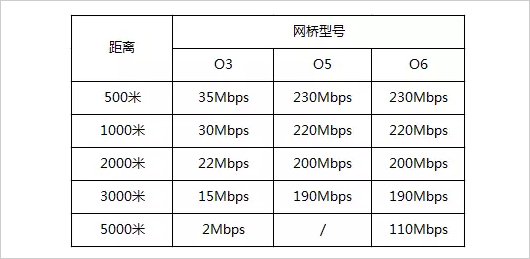How many cameras can a wireless bridge carry?
Many friends ask how many cameras a Gigabit wireless bridge can carry. In fact, this problem is more important than the algorithm of the switch. Let's take a look at it today.
Regarding the number of pairs of wireless bridges and surveillance cameras, we have to consider three factors: the bandwidth occupied by the camera, the transmission distance, and the transmission bandwidth of the wireless bridge.
First, the relationship between the number of bridges and the number of machines
As long as the relationship between the three is clarified, the selection and quantity planning of the wireless bridge and surveillance camera can be quickly determined in the wireless monitoring project.
The following is the calculation formula between the number of cameras and the transmission bandwidth of the wireless bridge:
Number of cameras = wireless bridge bandwidth / camera bit rate
Explain the bandwidth of the bridge inside, here is a little different from the switch, the bridge we usually buy is called the Gigabit bridge, his actual capacity is not 1000M divided by the code rate, which should consider a network Bridge real-time transmission bandwidth, 1000M bridge actual transmission bandwidth may be only about 100M, that is, only about 2 million pixels of the camera.
This is related to the transmission distance of the bridge and the performance, environment and interference of the bridge. How many cameras are connected to the bandwidth? Of course, the code stream can be connected in theory, but there will be no more. Explain the problem. Complex, but as long as you understand the working principle of WIFI is to know that the bandwidth of the bridge is not the main factor, time is very important, the more cameras, the shorter the communication time per camera, the entire period, the data just can not be completely processed in time is the upper limit So, once it can't be processed in time, the bridge will be unstable.

In fact, from another angle, suppose a bridge device, point-to-point bandwidth of thousands of meters, but when faced with multiple camera access points, this bandwidth is meaningless, the camera transmits data that is closely related to time, the bridge only It can be received one by one, and the unit bandwidth is no longer meaningful. The data of the camera is collected in real time, and the data that has been placed on the hard disk is two things. It will not be big because of the large bandwidth. There is no big data for you. The reading mechanism does not cache data for a long time, so the problem of processing the data is slow. That is, in one cycle, when a camera delays more than a certain time, it causes a full delay, and the terminal abandons the old data and requests the new data again. Only then resumed, and then delayed, the result is that the picture is stuck, the video content is out of time.
Second, the transmission distance and bandwidth of the wireless bridge
The relationship between transmission distance and transmission bandwidth is well understood. The farther the transmission distance is, the smaller the transmission bandwidth is. After all, the wireless bridge is transmitted by microwave, and the microwave has the effect of diffusion. When transmitting wirelessly over long distances, the microwave signal will be greatly weakened. Just like the farther away our mobile phone is from the WIFI source, the worse the signal is. The same reason.
For example, a 5.8G high-power wireless bridge, its theoretical transmission rate is 300Mbps, but in practical applications, often 60Mbps. If a 5 km field test was conducted, a transmission rate of 60 Mpbs was obtained. Then, according to the above formula, a 5 km wireless transmission can carry 10 streams with a 4 Mbps 130 W camera.
However, this can only be achieved under theoretical conditions. After all, transmitting data and transmitting video are two different things. In the wireless video surveillance project, users pay great attention to monitoring the smoothness of the video. The 130W camera has a stream size of 4 Mbps, but in high-definition video transmission, the dynamic stream in the transmission bandwidth may suddenly rise to 8 Mbps or even higher.
Therefore, when the 5.8G wireless bridge performs 5 km wireless transmission, it usually only has 5 or 6 130W cameras.
Of course, it is also possible to increase the real-time transmission bandwidth of the wireless bridge by adding a high-gain antenna, so that one or two cameras can be added.
In addition, there are two current video coding standards: H.264 and H.265.
The new video encoding technology H.265 can highly efficiently compress high-definition video, which is nearly double that of H.264. Therefore, the camera using H.265 video compression technology can also reduce the transmission bandwidth. contribution.
Third, you can give a reference value here.
According to the length of the transmission distance, the bridge can be divided into 3 km O5, 5 km O3, 10 km O6. Among them, O3 is a 2.4G bridge, and O5/O6 is a 5G bridge. The transmission performance of the bridge decreases as the transmission distance increases. Taking point-to-point transmission as an example, the correspondence table of the real-time bandwidth and distance of the bridge transmission is summarized according to the data of the actual use environment test for reference.

Fourth, the performance of the wireless bridge
Different wireless bridge performance determines their application environment. For example, a 5.8G high-power wireless bridge can transmit 5 kilometers, while another wireless bridge can transmit 50 kilometers, and even a wireless bridge capable of transmitting 100 kilometers. .
The difference in transmission distance depends on the performance between them, and there are many factors that affect the performance between them, such as the microwave frequency, device power, hardware configuration, software, transmission technology, and so on.
Liquid Adhesive Pump System,Industrial Glue Pumps,Liquid Glue pump ,Adhesive Pump ,Glue pump price
CHANGLONGXING SCIENCE & TECHNOLOGY (SHENZHEN) CO.,LTD , https://www.clxmachinery.com